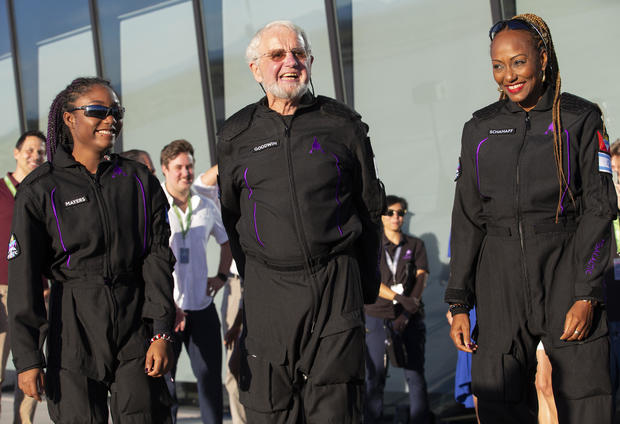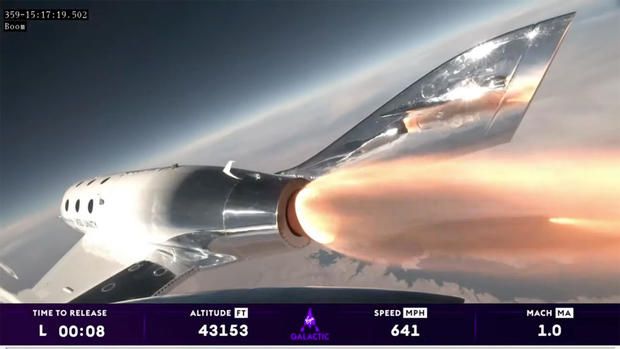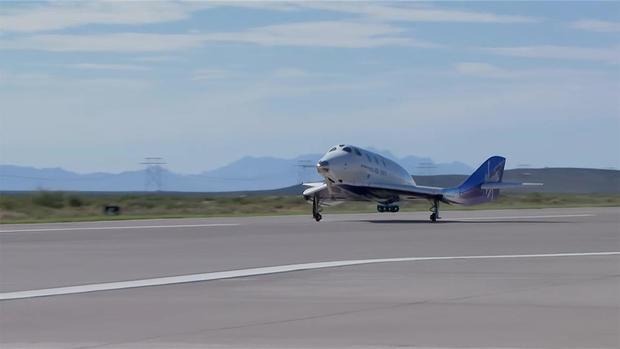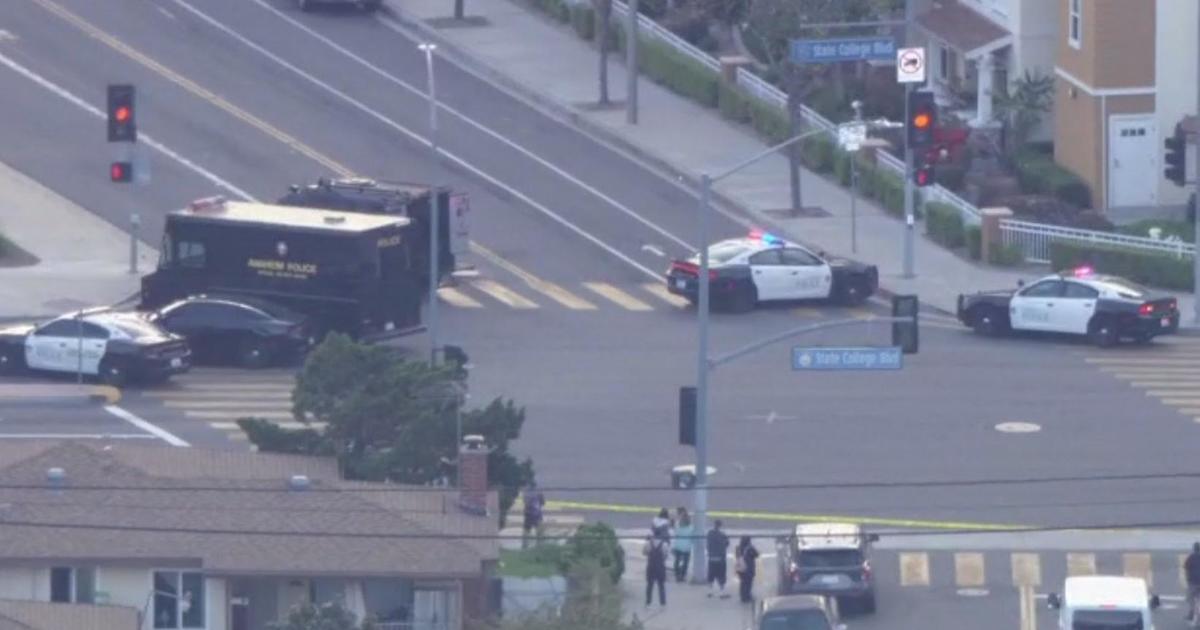Virgin Galactic launches its first space tourist flight, stepping up commercial operations
Richard Branson's Virgin Galactic picked up the pace in the space tourism marketplace with the launch Thursday of its VSS Unity rocketplane carrying an 80-year-old former British Olympian and a mother and daughter from Antigua and Barbuda who won their tickets to fly through a fundraising lottery for the nonprofit Space for Humanity.
Jon Goodwin, an Olympian canoeist in the 1972 Munich games, health and wellness coach Keisha Schahaff and her daughter Anastatia Mayers, a physics and philosophy student at Aberdeen University, were joined by Virgin Galactic commander C.J. Stuckow, pilot Kelly Latimer and chief astronaut trainer Beth Moses for the up-and-down sub-orbital spaceflight.
Schahaff and Mayers are the first mother and daughter to fly in space together and the first representing the Caribbean island nation of Antigua and Barbuda in the West Indies.
"That was like the most amazing thing I've ever done!" Schahaff said after landing. "Antigua went to space! A childhood dream has come true. I've been to space and back with my daughter. We're making history, and this is just beautiful. The pilots, everyone, they delivered exactly what they said it would be. And if anyone was wondering, Earth is round!"
Said Mayers: "I have no words. The only thought I had the entire time was wow, that's how I can sum up the experience. Just wow."
Judging by live-streamed views from inside the spacecraft as it reached a maximum altitude of nearly 55 miles — nearly five miles above the 50-mile altitude NASA and the Federal Aviation Administration recognize as the "boundary" of space — the passengers were clearly thrilled by the view and the few minutes of weightlessness they experienced.
It was Sturckow's record eighth flight to space — four aboard the space shuttle and now four at the controls of Virgin's spaceplane — while Moses, Virgin's chief astronaut instructor, took her fourth trip aloft aboard Unity. Latimer, Virgin's first female spaceplane pilot, took her first ride, as did the three passengers.
The flight marked a major milestone for Virgin owner Richard Branson, the billionaire entrepreneur and adventurer whose team has been struggling for years to transition from test flights to commercial passenger service, offering brief sojourns in weightlessness for those willing to pay $450,000 for a ticket to ride.
"The fact that I am here, the first to travel to space from Antigua, shows that space really is becoming more accessible," Schahaff said in a pre-flight statement. "I know I will be changed by my experience, and I hope I will be able to share that energy and inspire the people around me in my role as a life coach, a mother and as an ambassador for our beautiful planet."
Schahaff and Mayers won their tickets through a lottery benefiting Space for Humanity, a nonprofit founded by philanthropist and space entrepreneur Dylan Taylor that is devoted to "expanding access to space for all of humanity." Branson personally delivered the tickets.
Goodwin, who bought his ticket to fly in 2005 — the fourth person to reserve a flight — was diagnosed with Parkinson's in 2014. But that did not deter him or Virgin Galactic.
"That was by far the most awesome thing I've ever done in my life," Goodwin said after landing. "The thing that surprised me more than everything else was the beauty of the Earth from space. It is completely surreal. I've got some fast cars, but that acceleration was just unbelievable. Thank you Virgin Galactic. It's been 20 years for the wait. But it's been worth every moment of it. Thank you."
With the Unity space plane strapped to the wing of Virgin's twin-fuselage VMS Eve carrier jet, the flight got underway at about 11 a.m. EDT, taking off from Spaceport America's 12,000-foot runway in the New Mexico desert near White Sands Missile Range.
After climbing to an altitude of about 45,000 feet, Unity was released, dropping like a bomb from the carrier jet's wing. Seconds later its hybrid rocket motor ignited, propelling the ship up on a near-vertical climb out of the dense lower atmosphere.
Reaching a velocity of about three times the speed of sound, the rocket motor shut down and the crew was suddenly weightless. Unity continued upward, coasting to a maximum altitude of 54.9 miles.
As they climbed, arced over the top of the trajectory and began descending, Schahaff, Mayers, Goodwin and Moses were able to unstrap and float about the cabin if they wished — the pilots remained strapped in throughout — taking in spectacular views of Earth and space.
Then, with Unity's wings "feathered," that is, swept up about 60 degrees to increase atmospheric drag and slow the descent, the spacecraft plunged back into the discernible atmosphere. The wings then were rotated back to their more traditional orientation and the pilots guided Unity, now flying as a glider, back to touchdown at Spaceport America.
The flight was Virgin's second commercial mission, following on the heels of a flight June 29 that carried three Italian air force researchers, two Virgin pilots and a company engineer to an altitude of nearly 53 miles.
That flight was chartered by the Italian government while Thursday's flight was the first with "private astronauts." Virgin officials say some 800 applicants are on the waiting list to fly aboard the company's spaceplane.
Blue Origin, owned by Amazon-founder Jeff Bezos, has offered commercial sub-orbital flights aboard its New Shepard spacecraft since 2021, but the company is currently grounded amid work to resolve a booster problem that derailed an unpiloted research mission last year.
Thursday's flight was Virgin's seventh piloted sub-orbital mission since an initial test flight on December 13, 2018. After two more test flights, Branson and a crew of six completed the company's fourth space flight on July 11, 2021, climbing to an altitude of 53 miles.
After standing down to upgrade the Eve carrier jet, Virgin launched a fifth piloted test flight with six company employees on May 25, followed by the Italian research mission on June 29. Virgin plans to eventually ramp up to a flight per month.








